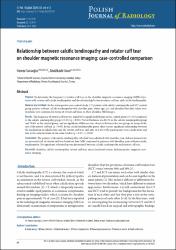| dc.contributor.author | Sucuoğlu, Hamza | |
| dc.contributor.author | Asan, Abdülkadir | |
| dc.date.accessioned | 2020-05-24T00:36:06Z | |
| dc.date.available | 2020-05-24T00:36:06Z | |
| dc.date.issued | 2020 | en_US |
| dc.identifier.issn | 0137-7183 | |
| dc.identifier.issn | 1899-0967 | |
| dc.identifier.uri | https://hdl.handle.net/11363/2155 | |
| dc.description | Document Information
Language:English
Accession Number: WOS:000520109500001
PubMed ID: 32180848 | en_US |
| dc.description.abstract | Purpose: To determine the frequency of rotator cuff tear on the shoulder magnetic resonance imaging (MRI) of patients with rotator cuff calcific tendinopathy and the relationship between rotator cuff tear and calcific tendinopathy.
Material and methods: In this retrospective case control study, 137 patients with calcific tendinopathy and 137 control group patients without calcific tendinopathy with shoulder pain, whose age, sex, and shoulder laterality values were matched, were compared in terms of rotator cuff tears on their shoulder MRI images.
Results: The frequency of rotator cuff tear was found to be significantly higher in the control group (37.2%) compared to the calcific tendinopathy group (23.4%) (p < 0.01). Partial thickness was 81.3% in the calcific tendinopathy group and 70.6% in the control group, and no significant difference was observed between the two groups in terms of the size of the rotator cuff tear (p > 0.05). In the calcific tendinopathy group, there was no significant relationship between the localisation of calcification and the rotator cuff tear, and only in 4.4% of the participants were calcification and tear at the same location on the same tendon (p > 0.05, r = 0.04).
Conclusions: The patients with calcific tendinopathy, who had been admitted with shoulder pain, did not demonstrate an increased risk of rotator cuff tear based on their MRI compared to patients with shoulder pain without calcific tendinopathy. No significant relationship was determined between calcific tendinopathy and rotator cuff tear. | en_US |
| dc.language.iso | eng | en_US |
| dc.publisher | INT SCIENTIFIC INFORMATION INC, 361 FOREST LN, SMITHTOWN, NY 11787 USA | en_US |
| dc.relation.isversionof | 10.5114/pjr.2020.92709 | en_US |
| dc.rights | info:eu-repo/semantics/openAccess | en_US |
| dc.rights | Attribution-NonCommercial-NoDerivs 3.0 United States | * |
| dc.rights.uri | http://creativecommons.org/licenses/by-nc-nd/3.0/us/ | * |
| dc.subject | shoulder | en_US |
| dc.subject | calcific tendinopathy | en_US |
| dc.subject | rotator cuff tear | en_US |
| dc.subject | musculoskeletal system | en_US |
| dc.subject | hydroxyapatite | en_US |
| dc.subject | magnetic resonance imaging | en_US |
| dc.subject | MRI | en_US |
| dc.subject | TENDINITIS | en_US |
| dc.subject | ASSOCIATION | en_US |
| dc.subject | EXPRESSION | en_US |
| dc.subject | DIAGNOSIS | en_US |
| dc.subject | Medicine | en_US |
| dc.subject | MEDICINE | en_US |
| dc.title | Relationship between calcific tendinopathy and rotator cuff tear on shoulder magnetic resonance imaging: case-controlled comparison | en_US |
| dc.type | article | en_US |
| dc.relation.ispartof | POLISH JOURNAL OF RADIOLOGY | en_US |
| dc.department | Sağlık Bilimleri Yüksekokulu | en_US |
| dc.identifier.volume | 85 | en_US |
| dc.identifier.issue | E8 | en_US |
| dc.identifier.startpage | E13 | en_US |
| dc.relation.publicationcategory | Makale - Uluslararası Hakemli Dergi - Kurum Öğretim Elemanı | en_US |



















